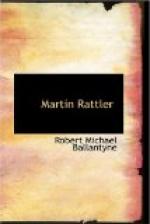When the young turtles issue forth and run to the water, there are many enemies watching for them. Great alligators open their jaws and swallow them by hundreds; jaguars come out of the forests and feed upon them; eagles and buzzards and wood ibises are there, too, to claim their share of the feast; and, if they are fortunate enough to escape all these, there are many large and ravenous fishes ready to seize them in the stream. It seems a marvel that any escape at all.
In a few minutes the old trader scraped up about a hundred eggs, to the immense satisfaction of Martin and Barney. Then he took a bow and arrow from the bottom of the montaria and shot a large turtle in the water, while his companions kindled a fire, intending to dine. Only the nose of the turtle was visible above water; but the old man was so expert in the use of the bow, that he succeeded in transfixing the soft part of the animal’s neck with an arrow, although that part was under water. It was a large turtle, and very fat and heavy, so that it was with difficulty the trader lifted it upon his old shoulders and bore it in triumph to the spot where his companions were busily engaged with their cooking operations. Turtles are frequently shot with the arrow by the natives; they are also taken in great numbers with the hook and the net.
Dinner was soon ready. Barney concocted an immense and savoury omelet, and the old trader cooked an excellent turtle-steak, while Martin prepared a junk of jaguar meat, which he roasted, being curious to taste it, as he had been told that the Indians like it very much. It was pretty good, but not equal to the turtle-eggs. The shell of the egg is leathery, and the yolk only is eaten. The Indians sometimes cat them raw, mixed with farina. Cakes of farina, and excellent coffee, concluded their repast; and Barney declared he had never had such a satisfactory “blow out” in his life; a sentiment with which Martin entirely agreed, and the old trader—if one might judge from the expression of his black countenance—sympathized.




